Mastering Christmas Decoration: A Strategic Guide
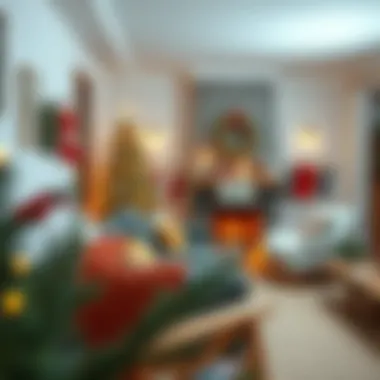

Intro
As December rolls around and the days shorten, the excitement for Christmas decorations begins to blossom. While some might think the decorations should come out the day after Thanksgiving, there's much more to consider than just the timing. Decorating for the Christmas season is less about throwing up a few garlands and more about curating a space that resonates with personal style while also considering practicality and mindset. It's about blending the traditional with the modern, all while being mindful of sustainability and cultural implications.
This guide navigates through the layers of Christmas decoration preparations, emphasizing a thoughtful approach to planning, execution, and the journey itself. Whether you're a retailer seeking the latest trends, a stylist crafting the perfect holiday ambience, or a blogger aiming to inspire your audience, there's intriguing wisdom to be unpacked here.
Fashion Trends
Current Season Highlights
In the realm of Christmas decor, every year seems to bring new designs and aesthetics to the forefront. While classic red and green are timeless, recent seasons have highlighted themes like minimalist Scandinavian designs and nature-inspired decorations. The playoff of using natural elements—think pine cones, sprigs of evergreen, and muted color schemes—achieves a serene but festive atmosphere. Furthermore, accents of gold or silver can effortlessly elevate the look, adding a touch of sophistication.
Social media platforms like Instagram and Pinterest have become go-to resources for observing the shifting trends. Winter whites paired with warm earthy tones have dominated many feeds. As a fashion designer, blending these color palettes into textiles for decorative pieces can create a cohesive look that speaks to the current season.
Iconic Looks Through the Ages
The evolution of Christmas decor is closely tied to cultural milestones. From Victorian grandeur with opulent decorations—such as intricate glass ornaments—to the DIY ethos reflecting the economic challenges of the 1930s, understanding the context behind these iconic looks can better inform current practices.
- The 1950s and 60s introduced a kitsch aesthetic highlighted by tinsel and bubble lights.
- The 1970s embraced a return to handmade ornaments, which fostered nostalgia and personal connection.
- Fast forward to now; we see a blend of nostalgia with innovation, as smart technology intertwines with festive displays, allowing for automated lighting and themed presentations.
This historical perspective shapes how we approach today’s decorations, where integrating unique styles, materials, and methods becomes a creative endeavor that honors tradition yet embraces new vernacular.
Fabric Care Tips
Washing and Maintenance Guidelines
Caring for decorations, especially fabric-based ones, is significant if you want them to shine through many seasons. For instance, ornaments made of felt or cotton require gentle care.
- For washing, it's often best to hand wash these items with mild soap and cool water.
- Avoid harsh detergents as they can dull colors.
- Dry flat in a well-ventilated area—beyond this, ensure items are stored properly, as improper storage can lead to fading and damage.
Doing so not only ensures their longevity but also upholds the vibrancy of the decor year after year.
Choosing the Right Products for Different Fabrics
Selecting the right cleaning product for fabric types is a noteworthy point of consideration. Here are some basic categories:
- Delicate fabrics like silk or lace require specially formulated cleaners that won’t harm the integrity of the fabric.
- Cotton can usually withstand a more robust cleaning approach but still benefits from color-safe detergents.
- Synthetic materials often require minimal care but do check labels to ensure compatibility of cleaning products.
Ultimately, when decorated with care, each item becomes an enduring part of your festive repertoire.
The importance of preparation cannot be overstated, as it significantly affects both the aesthetics and sustainability of your festive decorations.
By taking a thoughtful approach to your Christmas decorations, you foster a more fulfilling transition into the holiday season—one that honors not just looks or trends, but the deeper meanings and experiences the season heralds.
Setting the Stage for Holiday Decorations
As the festive season approaches, the way we set the stage for holiday decorations can greatly impact both our enjoyment and the ambiance of our surroundings. It's not just about throwing up some tinsel and lights; rather, it involves a deeper consideration of aesthetics, comfort, and emotional resonance. The decor we choose can reflect our personalities, values, and even cultural traditions. So, before jumping into the decorations, it’s wise to take a step back and think about the overall vibe we want to create.
Some benefits of a well-planned holiday decoration strategy are the ability to create a cohesive look, save time, and even decrease stress as the season gets busier. When you have a clear vision, you avoid the chaos of last-minute scrambles, which can lead to haphazard choices that don't quite resonate. Plus, a thoughtful approach can help you make better choices, ensuring that the decorations not only please the eye but also align with your personal tastes and values.
Defining Personal Style
Your personal style is the north star guiding your decoration choices. It’s the framework within which you’ll select colors, textures, and themes that speak to you. Understanding what resonates with your aesthetic can help you sift through the plethora of decoration options available. Consider what décor makes you feel comfortable and happy. Whether it’s the vibrant hues of traditional decorations or the soft tones of modern designs, your style is paramount in developing a space that feels homely yet festive.
Selecting a Theme
Choosing a theme can streamline your decoration process and provide a framework within which you can express your creativity. Here’s an exploration of four distinct themes:
Traditional
Traditional themes bring a sense of nostalgia. They often incorporate rich reds, greens, and golds, evoking images of old-world charm. The allure of a traditional holiday setup lies in its familiarity and comfort. Key characteristics of this style include the use of classic ornaments like glass baubles, handcrafted decorations, and time-honored motifs such as holly and snowflakes. When done well, a traditional Christmas theme is welcoming and reminiscent of childhood memories—there’s a reason many people gravitate towards this style.
However, one might argue that traditional themes can sometimes feel predictable. While it fosters a sense of continuity, it may lack the adventurous spirit found in other styles.
Modern
Modern themes often lean towards simplicity, utilizing neutral colors and geometric shapes. Key characteristics include minimalistic decorations that exude elegance without being overly ornate. The charm of this style is its cutting-edge approach that can effortlessly update your space while allowing inherent beauty to shine through.
A modern holiday setup is perfect for those who appreciate clean lines and want to steer clear of clutter. Yet, the disadvantage could be that it may lack the warmth and nostalgia that some seek during the holidays.
Minimalistic
Minimalism celebrates the idea of less is more. By focusing solely on a few heartfelt decorations, minimalistic designs emphasize quality over quantity. This theme offers tranquility amidst the holiday bustle, showcasing simple ornaments and natural elements such as wood and greenery.
Choosing a minimalistic approach can be refreshing, especially in a season often filled with excess. However, it may not resonate with those who prefer vibrant and diverse décor, and it could feel a bit sparse to holiday enthusiasts.
Whimsical
Whimsical themes thrive on imagination and playfulness. With bright colors, quirky patterns, and fun decorations, this theme invites a sense of joy and surprise. Key characteristics include unconventional colors and lighthearted motifs, making it perfect for families wanting to inject personality into their spaces.
The uniqueness of a whimsical theme can create joy and stimulate conversations among guests; however, some find it might be a bit too eccentric for their distinct tastes or might clash with more formal settings.
Choosing the right theme sets the foundation for your holiday décor. Each style has its own merits and challenges, highlighting the essence of what makes the holiday season special to you. Taking time to reflect on these considerations can lead to a more fulfilling and aesthetically pleasing holiday experience.
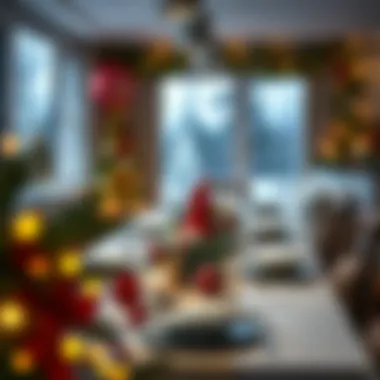
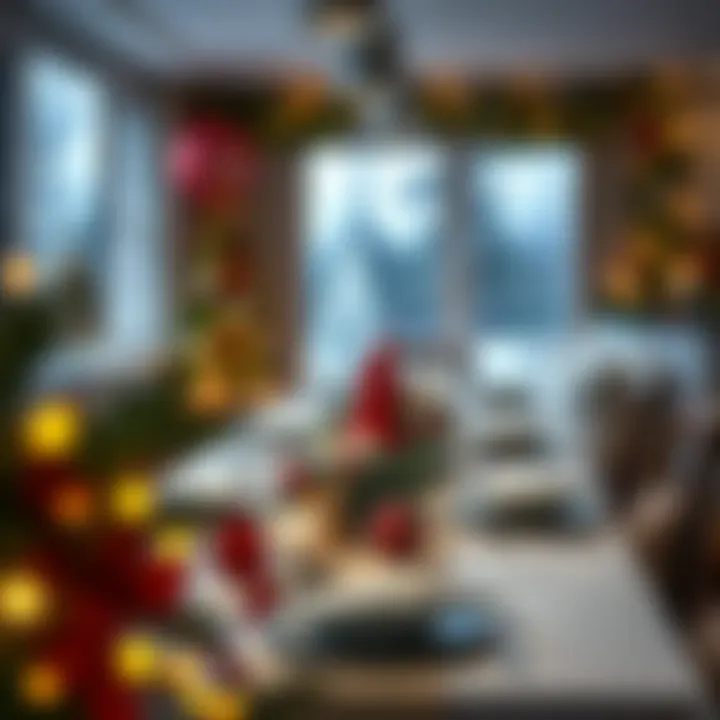
Planning the Countdown
In the bustling months leading up to Christmas, appropriately planning your decoration journey becomes a key component in ensuring that not only is your home visually appealing but also imbued with personal meaning. The countdown to Christmas isn’t just about the days ticking down on the calendar; it’s about cultivating an atmosphere that resonates with warmth, joy, and significance.
Without a solid plan, the frantic rush often leads to disorganization or missed opportunities for creativity. Thus, the planning phase is essential. It allows you to map out your vision, set clear priorities, and avoid the last-minute stress that can dampen the festive spirit.
The importance here lies in the specific elements that shape the overall experience:
- Timing: Setting a clear decoration timeline helps in pacing your decorating efforts. This means you’ll have ample time to plan, gather materials, and execute your ideas without feeling like you’re running out of time.
- Coordination: It provides a point of reference to ensure that all elements of your decoration align well visually and thematically, making each piece work to enhance the overall aesthetic experience.
- Flexibility: Even with a structured plan, being adaptable to changes can lead to unexpected creative opportunities. That might mean incorporating an idea that sprang from a visit to a local craft market or a gift from a friend.
Creating a Decoration Timeline
Creating a well-structured decoration timeline requires a balance of simplicity and detail. Start by marking out key milestones:
- Early Planning: This can start as early as November. Think about themes and research ideas that inspire your setup. Pinterest and lifestyle blogs often teem with fresh concepts that one might wish to explore.
- Material Gathering: Set aside time during the last weeks of November for procuring materials. Whether it's quaint ornaments from a quaint flea market or DIY supplies from a craft shop, timing can be everything.
- Setting Up: Decide on specific days in December for putting up decorations. Spreading this task across several days can keep it enjoyable rather than overwhelming. Consider focusing on specific areas, like the living room one day and the dining room another.
This timeline should be visible, perhaps even displayed in a way that keeps the excitement building. You might draft it on a colorful whiteboard or even in a shared digital calendar that all family members can access.
Budget Considerations
Budgeting for decorations can sometimes feel like walking a tightrope; you want to create magic without breaking the bank. Careful budgeting is important in ensuring that you can savor the joy of the season without financial stress. Here are some considerations:
- Set a Total Budget: Start with a clear amount you’re willing to spend. Factor in all possible expenses, from new decorations to food for holiday gatherings.
- Prioritize Spending: Identify what aspects of the decoration hold the most importance for you. Is investing in quality lighting more significant than buying a new set of ornaments? Establishing priorities ensures you spend your budget on what truly matters to you.
- DIY vs. Store-Bought: Understand what you can create yourself. DIY decorations often carry sentimental value and can save you a few bucks. However, buying certain items might be more cost-efficient than making them from scratch in some cases, so weigh your options carefully.
- Sales and Discounts: Keep an eye on local sales, especially after the holiday season. Shopping in January for next year’s items can be a smart way to save some cash.
"An investment in decoration isn’t just about now but about creating memories for the future to look back on fondly."
By formulating a budget alongside a timeline, you carve a path that not only nurtures creativity but channels resources efficiently towards the holiday ambiance you desire.
Choosing the Right Materials
Selecting the right materials for Christmas decorations is like laying the foundation for a house; it sets the tone for everything that follows. The materials you choose can impact not just the aesthetic appeal, but also how well your decorations hold up over time. Considerations such as durability, ease of maintenance, and the ecological footprint of the materials can guide your choices to create a meaningful Christmas atmosphere.
Natural vs. Synthetic
When deciding between natural and synthetic materials, it's crucial to weigh the pros and cons of each. Natural materials, like wood, burlap, or real greenery, often exude an organic warmth and charm that can enhance the nostalgic aspect of Christmas. Their varied textures and colors can lend an inviting, homely feel to your space. However, they may require more care than synthetic options. For instance, real pine may dry out and lose its aroma without proper hydration, while real wreaths can attract pests.
Conversely, synthetic materials such as plastic and polyester offer practicality. They are often more affordable, available in various styles, and can be reused year after year, reducing waste. That said, they can sometimes lack the authenticity and warmth of their natural counterparts. Choosing synthetic does not inherently equate to a lack of style or appeal; it all boils down to how you integrate those materials into your overall holiday theme.
Sustainable Options
Finding sustainable options for Christmas decorations has become increasingly important, as more people are mindful of their environmental impact. Utilizing eco-friendly materials not only adds a layer of responsibility to your decorating but can also enhance the beauty of your seasonal display.
Recycled Materials
Recycled materials have gained traction in many facets of decoration and design, and Christmas is no exception. By using items made from recycled components, you contribute to reducing waste while also creating unique decor. For instance, ornaments created from repurposed glass or old newspapers can add character to your tree, telling a story through their imperfections.
Key characteristic of recycled materials is their unexpected origins; you never know what history they hold. They can transform into conversation pieces, sparking interesting dialogues among your guests. However, keep in mind that the durability of recycled products can vary. It is essential to check for sturdiness, ensuring they don’t fall apart as you display them.
Locally Sourced Products
Locally sourced products present another exciting avenue for decoration. These materials not only reduce carbon footprint associated with transport but also support local artisans and businesses. Whether it's handcrafted ornaments from a local artist or seasonal foliage cut from a nearby farm, using locally sourced items allows your decorations to resonate with your community.
A key characteristic of locally sourced products is their uniqueness. You might find that no two items are exactly alike, which adds an element of individuality to your holiday decor. However, depending on the time of year and your location, the availability of these products may vary. If you can plan ahead, you can truly bring a piece of your local culture into your home during the festive season.
Using the right materials gives your decorations a strong foundation, influencing everything from aesthetics to sustainability.
Incorporating natural, synthetic, recycled, and locally sourced products can create a rich tapestry of textures and colors that embodies the spirit of the season while being mindful of larger implications. It encourages you not just to decorate but to think about what those decorations represent.
Incorporating Cultural Elements
In the realm of holiday decorations, the inclusion of cultural elements adds not just visual appeal but also layers of meaning and connection. When preparing for Christmas decorations, it’s vital to consider the diverse traditions that have shaped the way we celebrate. This rich tapestry can create a more inclusive atmosphere that recognizes the significance of various customs and practices. Thus, incorporating cultural elements in your decoration strategy is not only a nod to heritage but also enhances the overall narrative of the festive season.
Global Holiday Traditions
From the icy expanses of Scandinavia to the vibrant markets of Central America, holiday traditions vary widely across the globe. Each of these practices comes wrapped in its own unique identity—manifested through ornaments, colors, and techniques. For instance, consider how the German custom of Advent calendars has permeated many homes, creating a playful countdown to Christmas itself. Using similar elements can foster a spirit of anticipation and wonder in your own festivities.
Some traditions might include:
- Incorporation of Nativity Scenes: The depiction of nativity scenes is a central element in various cultures, sometimes crafted from local materials or designed to reflect regional art styles.
- Color Symbolism: Different cultures use colors symbolically during the festive season. For example, red and green signify Christmas joy in many Western cultures, while blue can represent truth and spirituality in others.
- Food-Specific Decorations: Items like gingerbread houses are staples in places like Germany, while cookies or sweets might dominate other regions. These edible crafts can even serve as decorations that unite guests and family around shared experiences.
Incorporating such traditions allows for an exciting fusion of ideas. A superb combination could be a white-and-blue-themed decoration that draws inspiration from both a Nordic winter and the spiritual connotations prevalent in many cultures. As these decorations intermingle, they create a dialogue between past and present.
Personal Heritage Impact
It's essential to reflect on one’s own heritage when choosing decorations. Personal history can dramatically influence aesthetics and the overall mood of your Christmas décor. This introspective approach not only beautifies but also tells a story—your story.
When considering your cultural background:
- Family Heirlooms: Many families pass down decorations that unlock cherished memories. A vintage ornament or a hand-knit stocking becomes a touchstone that evokes nostalgia.
- Traditional Crafts: Engaging in crafting traditional decorations is a way to honor heritage. You might want to try creating origami stars similar to those from Asian cultures or crafting floral arrangements inspired by Latin rituals.
- Cultural Fusion: Blending elements from various backgrounds can enrich your decorations. For example, draping a Christmas tree with decorations inspired by both African beadwork and European glass ornaments merges histories and resonates with inclusiveness.
Ultimately, as you embark on the journey of decoration, remember that personal and collective cultural influences transform a space into something meaningful and unique. Embrace the nuances, and let these elements guide your creations, ensuring that your surroundings reflect the multifaceted beauty of the holiday season.
"Cultural elements do not merely embellish; they deepen our connections and enrich the fabric of our celebrations."
For additional reading on cultural traditions, you might visit resources like Britannica or explore community-contributed insights on Reddit.
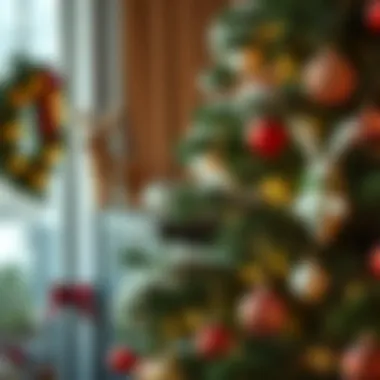
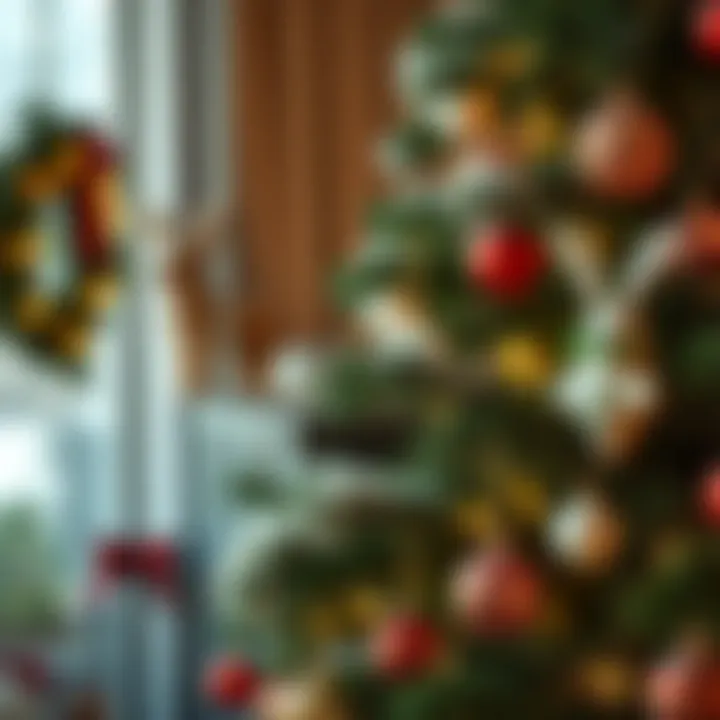
By exploring global traditions and reflecting on personal heritage, one can craft a Christmas ambiance that resonates with meaning and joy, making the holiday experience all the richer.
Utilizing Lighting Effectively
Lighting plays a pivotal role in creating the right ambiance during the Christmas season. It’s not just about illumination; it’s about evoking emotions, setting moods, and accentuating the beauty of your carefully curated decorations. Effective lighting can transform a mundane space into a magical winter wonderland, enticing and captivating those who walk through your threshold.
It’s essential to consider how different lighting sources can enhance your overall decor. Incorporating varied types of lights not only serves functional purposes but also adds layers of warmth and excitement. Think of how soft, glowing lights invite relaxation, while brighter, twinkly lights bring a sense of festive joy into the atmosphere.
String Lights and Their Placement
String lights are a quintessential element of Christmas decorating. Their charm lies not only in their ability to illuminate but also in their versatility. They can be draped over mantles, hung around windows, or woven through garlands. Proper placement can significantly amplify their effect, creating a seamless flow of light that guides the eye through your decor.
When it comes to positioning string lights, consider the focal points of your room. For instance:
- Draping Across Surfaces: Letting the lights cascade down can create a waterfall effect that draws attention.
- Framing Windows: Outline the edges with string lights for an inviting exterior view at night.
- Accent Walls: Use them to highlight decorative features like artwork or greenery.
Importantly, keep in mind color temperature. Warm whites tend to enhance cozy, nostalgic feelings, while cool whites might contribute to a more modern aesthetic. The choice of wire—either visible or hidden—will also affect the overall look. As you place these lights, take a step back regularly to ensure they flow harmoniously with your decor.
Candles and Mood Setting
Candles bring a unique warmth and intimacy that electric lights often lack. Their flickering flames create shadows that dance across walls, adding depth to any room. While modern technology offers battery-operated options, traditional wax candles still hold a timeless charm. They are imbued with the essence of the season, calling to mind family gatherings and cherished memories.
Consider different types of candles:
- Scented Candles: These can evoke the spirit of Christmas, giving off aromas like cinnamon, pine, or vanilla that trigger nostalgic emotions.
- LED Candles: For safety and convenience, these provide a similar aesthetic without the worry of an open flame.
When arranging candles, think about their height and placement for optimal effect. Group a variety of sizes together to create visual interest, or line them along a pathway or table.
"Lighting is an art form that can evoke comfort, joy, and nostalgia, especially during the holiday season."
Moreover, choose candle holders that resonate with your overall theme; whether rustic wood, shiny metals, or elegant glass, they can elevate your decor. Incorporating candles in unexpected places—like the bathroom or on outdoor tables—can also enhance the mood, creating a cohesive experience throughout your home.
In summary, effectively utilizing lighting can enhance your Christmas decorations, making your space feel inviting and merry. As an integral part of your decor strategy, select your lighting sources thoughtfully, ensuring each piece contributes to the overall atmosphere you wish to cultivate.
Emphasizing Natural Elements
As the holiday season approaches, bringing the beauty of nature into your Christmas decorations becomes a focal point for many decorators. Utilizing natural elements not only adds aesthetic value, it also instills a sense of warmth and authenticity into your space. From evergreen boughs to fragrant spices, the goal is to connect your home with the organic world around it, enhancing both the visual appeal and the sensory experience of your decorations.
Incorporating Seasonal Foliage
When thinking about seasonal foliage, one might consider how vibrant greens can truly transform a space. Think of how even a simple sprig of holly can brighten a room or give it that classic festive touch. Incorporating foliage like pine, spruce, or fir not only makes the environment feel inviting but also serves practical purposes such as scent and air purification.
- Texture: The varied textures of leaves and needles can create layers in your arrangements. Mixing bold, broad leaves with slender, sharp ones adds visual interest.
- Color: Seasonal foliage also introduces a palette of greens, greens, and even bright reds or whites from berries that can complement your overall theme.
- Environmental Responsibility: Another layer of incorporating natural foliage is the nod toward sustainability. Using locally sourced materials diminishes your carbon footprint and fosters a deeper connection between your home and the seasons around you.
To truly embody the spirit of the season, consider exploring local markets or farms where you can find fresh, seasonal supplies. They often have unique offerings that may not be available in the big-box stores, adding a bit of local flavor to your decorations.
Utilizing Pine and Cedar
Pine and cedar are not just staples of holiday decoration; they are symbols of strength and resilience. When utilized effectively, they can evoke a traditional and rustic atmosphere that resonates in many cultures around the world. The natural oils in pine and cedar enhance the sensory experience, providing a distinctive scent that many associate with the holiday season.
- Durability: Both of these materials tend to be more long-lasting than other decorative elements, holding up well against varying temperatures, which is particularly beneficial for outdoor displays.
- Versatility: Pine and cedar can be used in wreaths, centerpieces, or garlands, and they can be intermingled with other natural items for a more dynamic feel. Be it adding cones or berries, the combination can foster a rustic charm.
- Crafting Opportunities: If you're inclined toward DIY projects, crafting with pine and cedar opens innumerable doors—think about making scented sachets for drawers or using pine needles for a unique take on traditional potpourri.
By prioritizing natural elements, you're not just decorating; you're creating a layered experience that tells a story—a narrative that resonates with history, sustainability, and personal family traditions.
"Bringing nature inside during the holiday season is more than aesthetics; it's about creating a warm and inviting atmosphere that connects us to the earth."
For more insights about sustainable practices in decoration, check out resources on Sustainable Practices and Home Decoration Ideas.
In summary, incorporating natural elements like foliage and specifically pine and cedar into your decor not only elevates the festive atmosphere of your home but also aligns your personal style with greater environmental consciousness. A thoughtful approach to these materials can lead to stunning displays rooted in both creativity and sustainability.
Garland and Wreath Creation
Garlands and wreaths are more than just decorative elements; they serve as the soul of any Christmas decor. These decorative pieces create warmth, welcoming anyone who steps foot into your holiday abode. Moreover, garlands and wreaths can express personal creativity and style, enhancing one's unique holiday experience. With a thoughtful design, they can set the entire mood of the season, balancing tradition and contemporary flair.
DIY Approaches
Creating your garlands and wreaths can be a fulfilling endeavor that stretches beyond the mere act of decorating. It allows you to showcase your personality and intent in crafting a distinctive holiday atmosphere. Here are some tips for a successful DIY creation:
- Material Selection: Start with fresh or dried greenery, such as pine, eucalyptus, or even magnolia leaves. Combine textural elements like berries or dried citrus slices for that extra pop of color.
- Embellishments: Think outside the box. Instead of traditional ornaments, consider adding local treasures like pine cones, twigs, or even hand-painted wooden shapes.
- Techniques: Use wire to tie stems together and create form, or hot glue for a more sculptural approach. A little creativity goes miles—twisting in fairy lights can elevate your creation beautifully.
In this vein, consider the actual form: a lush, full wreath can evoke a sense of abundance, while a more minimalist garland conveys meandering elegance. It’s about reflecting your inner creativity and inviting others into your space. Above all, don't rush the process; let each element resonate with personal significance.
Choosing Pre-Made Options
Opting for pre-made garlands and wreaths does not indicate a lack of creativity; rather, it reflects a savvy approach to seasonal decor. In today's market, options range from the lavishly adorned to minimalistic designs, fulfilling various aesthetic preferences. When selecting pre-made options, keep the following in mind:
- Material Quality: Look for arrangements crafted from high-quality materials. Faux options can be remarkably life-like, but ensure they will withstand wear and tear throughout the season.
- Sustainability: Many brands now focus on sustainable sourcing—choose garlands and wreaths that minimize environmental impact. Brands that utilize recycled materials or ethically sourced flora will bring you peace of mind.
- Style: Ensure the garland or wreath aligns with your overall theme. A traditional green and red arrangement might clash with a modern aesthetic, while a chic minimalist piece may perfectly complement a contemporary vibe.
Moreover, curating a collection of versatile pre-made options allows for easier adjustments as you update your home throughout the season.
"The right garland or wreath transforms not just a room but the entire mood of the home, effortlessly bridging styles and stories together."
Selecting Ornaments with Purpose
Choosing ornaments is not just about aesthetics; it goes deeper into the heart of the holiday celebration. Selecting ornaments with purpose allows you to weave stories into your decor, creating an environment rich with memories and personal significance. Each ornament can represent a feeling, a family tradition, or even a milestone. It’s this thoughtful selection that transforms a mere collection of decorations into a narrative about who you are and what you cherish.
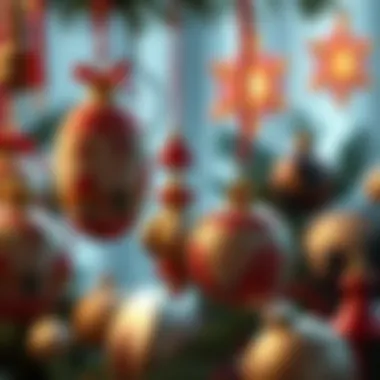
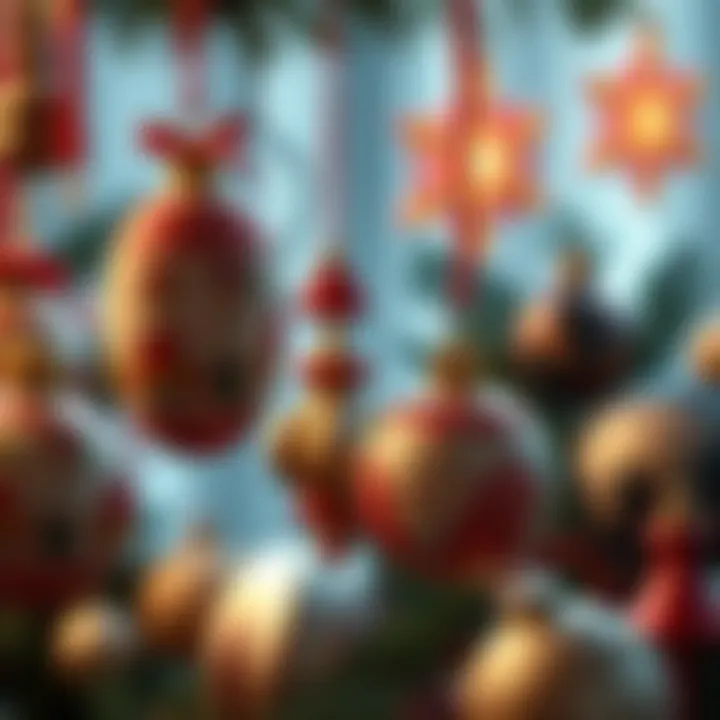
By selecting ornaments that resonate with you, the task becomes a celebration of individuality. This kind of intentionality can turn any ordinary tree into a magnificent tableau of life’s moments. Not only does it foster a deeper connection to your decorations, but it can also spark conversation and nostalgia among friends and family, making the holidays all the more special.
Historical Significance of Ornaments
The history of Christmas ornaments stretches back centuries, and understanding this heritage adds a layer of depth to the decorations we choose. Traditionally, ornaments were handmade and often connected to various cultural practices. For example, in Germany, the tradition of glass ornaments began in the 19th century, representing local artistry and craftsmanship. Likewise, in other parts of the world, ornaments made from natural materials were popularized, infusing decoration activities with local flora and fauna.
Moreover, ornaments can signify personal stories. Each piece tells a tale—perhaps a glass bulb from a great-grandmother, or a wooden star carved on a family trip. It’s a way to honor lineage.
“Every ornament is a reflection of history: of family, of tradition, and of love.”
Including ornaments with historical significance can provide students of design and history alike with a glimpse into the cultural practices of yesteryear, thereby enriching one’s own decorations while paving the path for future generations to appreciate these traditions.
Personalized Creations
On the other hand, personalized ornaments offer a fresh, modern twist that invites personal expression. Beyond traditional items, you can create or commission ornaments that encapsulate significant moments or hobbies. Think of a ceramic ornament shaped like a favorite vacation spot, or a painted bauble depicting a family pet.
This not only serves as an attractive addition to the decoration but also encourages creativity and participation from the whole family. Consider organizing a craft night where everyone paints their own ornament, or perhaps includes a handwritten message or date that holds meaning.
In an age of mass production, personalized ornaments stand out, capturing intellectual and emotional attachments that off-the-shelf products often lack. Their uniqueness adds character to your decoration scheme and reflects values of individuality and personal narrative, making your environment truly yours.
Final Touches to Decorations
The final touches to your Christmas decorations hold significant weight in creating an inviting and festive atmosphere. As you approach the culmination of your decorative efforts, these finishing elements are crucial in weaving together your chosen theme and style. They serve not just as enhancements, but as essential threads that tie the entire decoration scheme together. In essence, they can transform a decent setup into one that feels warm, welcoming, and genuinely festive. Let’s dive into the specifics of adding those last flourishes, focusing on textiles and the meaningful display of family heirlooms.
Integrating Textiles
Table Linens
Table linens are more than just functional items; they are the canvas upon which your holiday meals are painted. Incorporating beautifully textured or vibrantly colored table linens can elevate the visual appeal of your dining space, creating a splendid feast for the eyes, even before the food graces the table. Linen, cotton, or even velvet can serve as a backdrop that complements other decorative elements.
The key characteristic of table linens is their ability to be both seasonal and timeless, making them a favored choice among designers and decorators. Rich colors such as deep reds or forest greens capture the essence of the holiday spirit, while classic white can lend an air of elegance. Flexibility offers significant advantages when planning your overall decor.
On the other hand, you might ponder the cleaning and upkeep that table linens entail. Stains can become an issue, so opting for materials that are easy to clean after a big family gathering is vital. The balance of beauty and practicality becomes essential here.
Throw Pillows
Throw pillows are another brilliant accessory that adds layers of comfort and style to your space. They enhance seating areas while also providing an opportunity to inject patterns and colors that reflect your holiday theme. When it comes to throw pillows, the options are plenty: from cozy knits to intricate embroidery, there’s a style that resonates with every personal preference.
A standout feature of throw pillows is their versatility. They can be swapped out seasonally or even as your mood shifts. Many shoppers find that they offer an easy, cost-effective way to refresh a living space without committing to a complete overhaul of existing furniture or decor. This allows for a semblance of dynamism in a traditional setting.
However, it’s worth noting that with many options come different levels of comfort and durability. Choosing higher-quality materials ensures that they withstand the rigors of frequent use—especially with family and friends visiting during the holiday season.
Displaying Family Heirlooms
Family heirlooms carry with them stories and memories that add a personal touch to your holiday decorations. These sentimental items can range from vintage ornaments passed down through generations to cherished ceramics used in festive gatherings. Integrating such pieces creates a rich tapestry of family history within your holiday decor.
It’s essential to consider how these heirlooms will be displayed. Strategic placement can turn a simple decorative item into a focal point. Whether you're showcasing a handmade ornament on the tree or placing an antique serving dish in a prominent spot on the dining table, each piece evokes nostalgia and connection.
However, care must be taken regarding the delicate nature of many heirloom items. Proper handling and occasional maintenance may be necessary to preserve their beauty and integrity. Emphasizing heirlooms contributes not only to the visual landscape but also enriches the emotional experience of the season, reminding us of shared pasts and familial love.
Tip: When displaying family heirlooms, consider creating a dedicated space or a themed vignette that speaks to your family's history and traditions. This not only honors those who came before but also allows new memories to be woven into the fabric of your celebrations.
Maintaining the Decor Throughout the Season
As the festive spirit of Christmas twirls around our homes, maintaining the decor throughout the season is more than just a routine. It’s about nurturing an atmosphere that reflects joy and warmth in our spaces. Keeping decorations tidy and refreshed not only enhances their visual appeal but also ensures they are safe for the family. As days go by and life gets hectic, having a well-maintained set of Christmas decorations can lift spirits, evoke memories, and add a dose of cheer amid the winter chill.
Cleaning and Care
Enduring Materials
When it comes to Christmas decorations, using durable materials can be a wise investment. Enduring materials, such as metal, glass, and high-quality plastics, stand the test of time. They often withstand the occasional bump and bruise that comes with holiday hustle, making them a popular choice for decorations.
For instance, metal ornaments can amaze with their shiny appearance and resilience, and they seldom lose their charm even when stored away year after year. Unlike fragile materials which may need frequent replacement, enduring materials offer longevity with reduced hassle. Furthermore, they can be easily wiped clean, helping to maintain that festive glow throughout the holiday. However, one must remember that not all enduring materials are created equal; some can be heavier and may require sturdier hooks or support.
Advantages:
- Longer lifespan
- Easy to clean
- Can withstand wear and tear
Disadvantages:
- Heavier materials could pose a risk of falling
- Sometimes pricier than less durable alternatives
Seasonal Considerations
The essence of Christmas decor is tied closely to the season itself, making seasonal considerations an essential aspect to keep in mind. The weather changes and seasonal festivities can impact how your decorations fare over time. For instance, decorations displayed outdoors are exposed to the elements: wind, snow, and rain can take their toll. Choosing weather-resistant options allows for enjoyment without worrying about them fading or breaking.
Moreover, considering how temperatures shift can guide choices. As winter progresses and temperatures drop, lighter, more delicate decor inside can balance out with cozy, sturdy items outside. This reflection of the season’s character enhances the overall feel and spirit of the decorations. While refreshing the decor can be beneficial, it’s important to keep in mind that some materials may not be suitable for transition between indoor and outdoor use.
Advantages:
- Ensures the decor fits the seasonal mood
- Encourages creativity based on weather conditions
- Helps to preserve decorations in good condition
Disadvantages:
- Requires regular assessment and updating
- May limit some design choices based on material performance
Refreshing Specific Areas
As the holiday season unfolds, refreshing specific areas of your home is an art. Rather than overhauling everything at once, making small adjustments can revitalize the space without feeling overwhelming. This could include rotating decorations among different rooms, adjusting the arrangement of ornaments, or swapping out greenery to keep it looking fresh. Think of it as a continual curation of your holiday experience, allowing each corner of your home to feel loved and festive.
Involving family in these little updates can make the process even more delightful, breathing new life into the decorations while creating sweet moments together.



